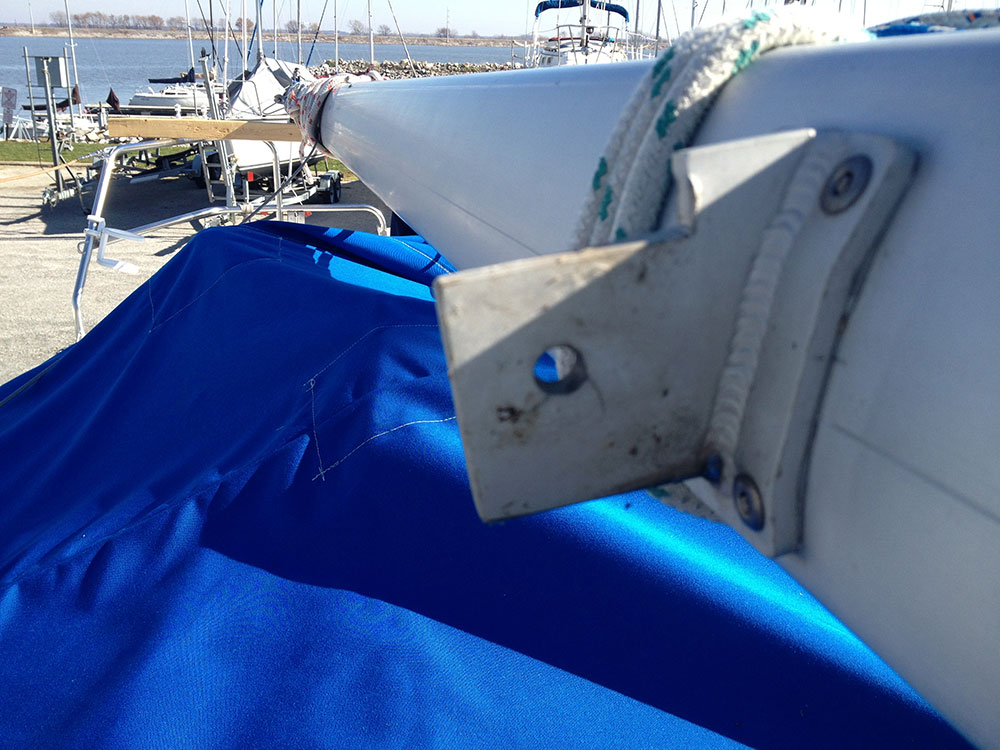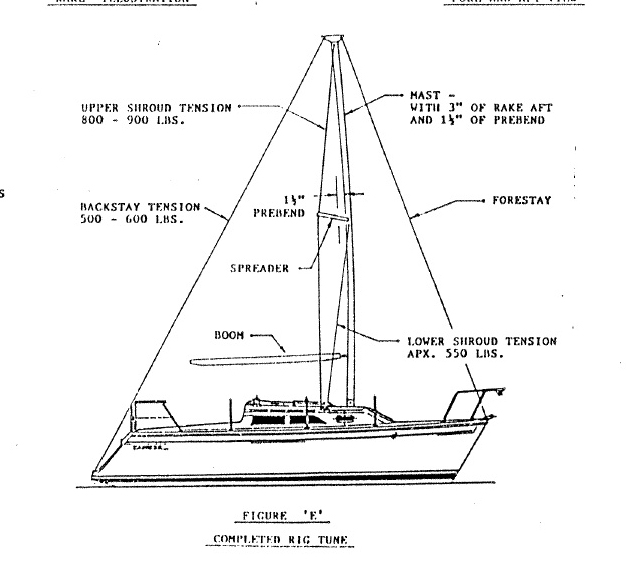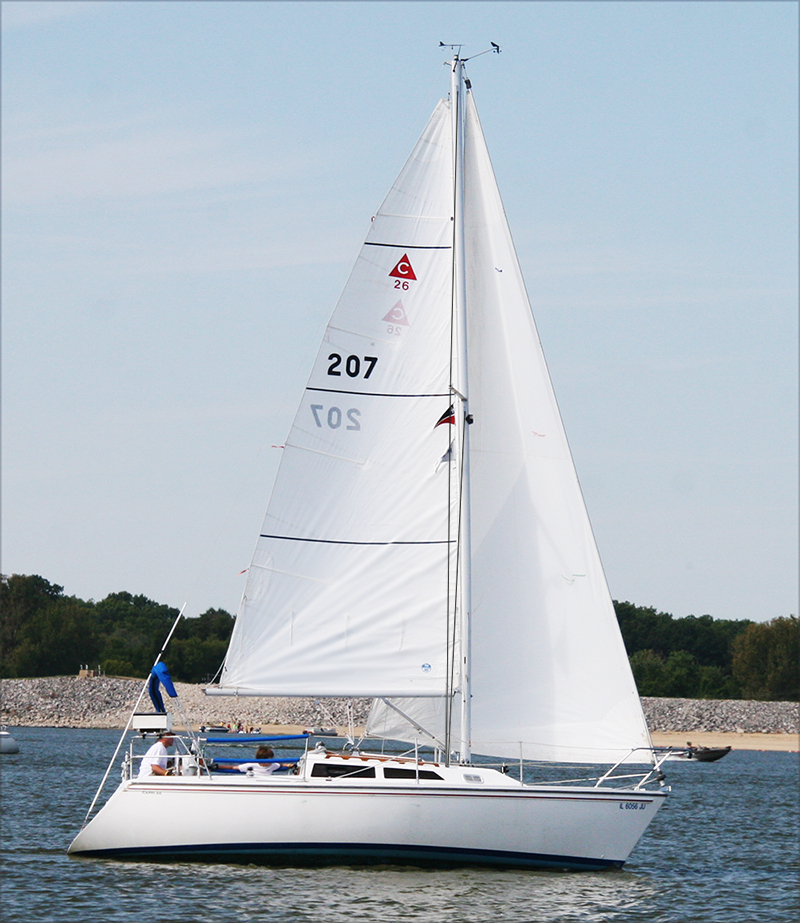
 |
| EDUCATION | CATALOG | RIGGING | CONSULTATION | HOME | CONTACT US |
|
#1
|
|||
|
|||
|
Hello
I have a Catalina Capri 26 which calls for a 3" rake and 1.5" of pre-bend however I'm unable to achieve any pre-bend even with the 1/8" shim (under the mast foot) that Catalina offers. The Capri has a mast head rig w/ swept back spreaders and I've noticed that over the years, the spreaders have developed some horizontal play (2” from front to back) and I'm just contributing the extra play from the years of the pin hole being slighting wallowing out from age. With my spreaders having “play”, I’m starting to think that if the (my) Spreaders are not rigid to the mast, it would not matter how much stay tension I would apply, the spreaders would not be able to do their job and help introduce any bend. Am I correct in thinking this? On a mast head rig, would swept back spreaders act the same way as on a fractional rig?   Cheers Stephen |
|
#2
|
|||
|
|||
|
Hi,
So many variables here. Let's start with how the spreaders contact the spreader bases. It appears that the spreader rake is not the same as the spreader tenon rake, with the latter being greater. Hence the wear on the forward edge. Theoretically, as the mast bends forward the two surfaces will line up, but this is just another way of saying that the spreaders and their bases are only aligned at one state of tune. And we don't even know if, when they are aligned, we will have the bend we want. Next, the spreaders, their bases, and the upper shroud chainplates must all be in alignment; if the chainplates are too far forward, no amount of tension will induce mast bend. If you sight up each upper, the wire should take a fairly straight course from deck to masthead, in the plane that the spreader is in. If it doesn't, then either the spreader angle is wrong, the chainplate location is wrong, or both. Finally, relative jibstay and backstay length and tension will be a major factor. If the jibstay is too short and/or the backstay too loose, for instance, the top of the mast will want to stay forward. What kind of tuning numbers are you getting? Next, lower shroud tune could be fighting the spreaders. I believe that your boat, like the majority of sailboats, the forward lower has a smaller fore-and-aft angle than the aft lower. If this is so, then even tension on the wires will result in the middle of the mast going aft, not forward. Getting back to those spreaders, the damage you are seeing is not a good thing. Once you have the other variables sorted out, see about bushing the clevis pin holes, and re-shaping the inboard edges. Fair leads, Brion Toss |
|
#3
|
|||
|
|||
|
Brion
thanks so much for the explanation, it is very much appreciated. I have been struggling with this problem for years. It takes everything just to keep the mast straight and without any reverse bend in the mast. So, I'm assuming that any play with the spreader rake is not good. The spreaders should be rigid to the base/mast? Catalina has improved the design of the base over the years, I might need to reach out to them and see if I can upgrade the spreader base. I attached a line drawing of the Capri. you will notice that the chainplates are aft of the mast and she was designed with only one set of lowers. In reference to the numbers (also see sketch), I follow the tuning recommendations from Catalina and check all of my numbers with a loos gauge.  Cheers Stephen |
|
#4
|
|||
|
|||
|
Aha,
I had forgotten that it was an aft-lowers-only rig, though this makes sense with swept-back spreaders; rigs like this with forward lowers -- and they exist -- end up with overloaded aft lowers. In your case, it appeared that the sweep on the spreaders was less than planned, because the forward edge was what was being crushed, right? If that's the case, it might be because the upper shroud chainplates were too far forward. And if so, that would mean the the spreaders were exerting less forward push than planned, and that in turn would mean that the aft lowers meet with too little resistance. Result: with any kind of tune on those lowers, the mast inverts. I recently struggled with this on a friend's Halberg 34, and ended up keeping the lowers slacker than I liked, in order to keep the mast right. Seems to be working. Anyway, another possibility is that the spreader base is simply cut at the wrong angle, and/or that the tenon is positioned incorrectly, and/or that the primitive bases are going to give you grief regardless. In any event, if you aren't going to move the upper shroud chainplates, then you need to get the spreaders to line up with their bases, for fixed-position spreaders, or fabricate swinging spreaders, which is a whole other can of variables. What diameter wire are we dealing with here? The numbers on the sketch would be right for 3/16". Fair leads, Brion Toss |
|
#5
|
|||
|
|||
|
Just as an aside, many rigs allow for considerable flex in the direction normal to the stay, whether this is spreaders or a dolphin striker.
The spreader needs to bisect the angle that it creates in the stay to avoid slipping up or down, but under tension it will automaticly find the fore and aft angle that allows for the shortest distance. If you've a flexable joint (such as I always install on the striker for a bobstay since without the flex, the joint will sooner or later fail due to anchor or mooring rode side stresses) you can see this for yourself by just pushing on the spreader and feeling the resistance. Or set up a line between two trees and push it out of straight with a stick from the ground. You'll see how this 'spreader' will find its angle and will be stabile then so long as the end away from the stay is past a line between the two ends of the stay. Simple force geometry. In the swept rig, you absolutely must have some room for the spreader to swing aft as you increase stay tension and bend the mast. On many traditional rigs, spreaders that are rigid in the fore and aft will fail at the joint due to flexing stresses that happen as the unloaded lee stay takes a strain when tacking. G'luck. |
|
#6
|
|||
|
|||
|
Brion/Ian,
You are correct, the stays are 3/16 and I'm not able to make any adjustments to the location of the upper chainplates. Since the mast is down for the winter, I'm unable to site up the shrouds but I was able to locate a side picture (and I highlighted the stays for better visiblity). Although it appears that the upper's are fairly straight from deck to masthead, it's now easier for me to visualize the problem that you (both) pointed out and how I might be having a problem. If I correctly understand Ian, once tension is applied on the shrouds, the shrouds will force the spreaders to "find" its angle, either fore or aft and by the signs on the spreader base, it appears that the spreaders are being forced forward resulting in the spreaders not being able to introduce pre-bend. Just to recap: Even though I'm following Catalina's spec's on loading to the tee, I'm thinking that I have too much tension on the lowers which is not allowing the mast to flex and it's forcing the spreaders forward. This should be a easy correction/fix. It now appears that I do have a problem with the spreader base from the inboard edges, to the wallowing of the clevis pin holes from years of wear. Fixing the pin holes should be straight forward but how do I ever determine the proper angle of spreaders? Or by Ian's comments, should I expect to see some swing (of the spreaders) to the aft as I tighten the shrouds but try to control any forward movement? It just seems like a delicate balancing act with swept back spreaders.  |
|
#7
|
|||
|
|||
|
Brion is far more scientific and knowledgable in tuning that I am, but on boats like this with a not particularly extreme spreader rake, I tune by first getting the head stay and back stay about right, then using the upper to center the truck. For this stage the lowers are slack. With swept spreaders, besides getting the truck centered I try to induce whatever mast bend I want. Only when that's done do I tension the lowers.
G'luck |
|
#8
|
|||
|
|||
|
Hi again,
It might be only the perspective, but it looks from the photograph that the chainplates are much further forward than in the sailplan. Wouldn't be the first time something like this has happened. It would account for the spreader root damage, assuming the roots and spreaders were built for a greater aft sweep. It would also account for your inability to bend the mast, as the sweep would have too small a forward vector to make much difference. On the other hand, the lowers would still have enough sweep to bend the middle of the mast aft. A quick Web search doesn't reveal any Capri's with chainplates further aft than yours, however. With the rig as-is, I'm with Ian: tune from the top down, and be moderate in your takeup of the lowers. Fair leads, Brion Toss |
|
#9
|
|||
|
|||
|
Brion & Ian
Thanks for all your help!!!! It was very informative. Happy Holidays Steve |
|
#10
|
|||
|
|||
|
Hello:
Here is my first post. I also have a Capri 26 and have had problems keeping the mast from inverting. I don't think my spreaders have wiggled so much but I may not have as many miles on the boat. After retuning the mast about a dozen times per the Catalina directions without any success, I (with the help of a rigger) figured out that the deck was compressing under the mast. While the mast is off the boat snug up the 4 1/4-20 screws that hold the mast step in place. I did this and when the mast was up and tuned the nuts on the bottom were loose, particularly the aft ones. My solution was to beef up the mast step area in the cabin sole and epoxy some vertical 3/8" diameter aluminum rods in the deck to take the compression load from the mast step to the compression post inside the boat. After doing this operation the mast maintained its prebend and I overstood the weather mark 2 or 3 times in the next race. There is a big hole in the deck for the mast wires and after 20 years in the rain the mast step was a little soft. I also poured lots of git-rot in the holes to hold the aluminum rods in place. The hardest part was filing the rod ends flush with the deck. Good luck and Happy Sailing Steve |
 |
| Thread Tools | |
| Display Modes | |
|
|